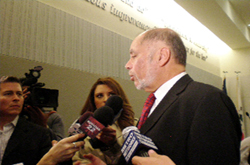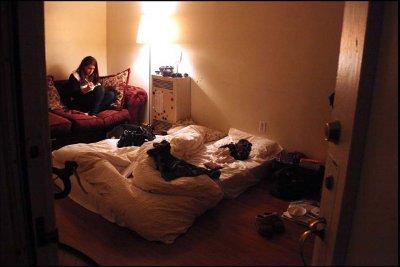Los Angeles Police Chief Charlie Beck sat with the Los Angeles Police Commission as they announced the results of an investigation into the shooting death of Guatemalan day laborer Manuel Jamines. Police Commission President John W. Mack said the three officers acted lawfully when they pulled out their weapons. The investigation also found that Frank Hernandez, the officer who shot and killed Manuel Jamines, followed LAPD protocol when it came to “the categorical use of force.”
Mack read the statement to a packed meeting at the downtown police department. He said the investigation, headed by Inspector General Nicole Bershon, was “comprehensive” and “exhaustive.”
Manuel Jamines, 37, was shot near Sixth Street and Union Avenue in MacArthur Park on September 5th. He was allegedly drunk and waving a knife in the air when three Rampart division police officers on bicycles found him. They issued orders to Jamines in Spanish and English to put the knife down. When Jamines raised the weapon and went toward them, Hernandez fired two rounds.
A day laborer named Tambric (he declined to give his first name) said he roomed with Jamines in an apartment on Wilshire Boulevard and Bonnie Brae Streetfor about four months. Tambric said he is from Nahuala Solola, the same small town in Guatemala where Jamines was from.
“He was a very nice person, but when he was drunk he was a noisy person,” said Tambric, through a translation by Jeronimo Salguero, co-director of the day laborer center CARECEN.
Luis Carrillo, a Pasadena lawyer representing the Jamines family, said he didn’t expect much from the announcement and that he was there “just to hear the script.”
|
Luis Carrillo, Jamines family lawyer, tells reporters the results of the investigation are just a “script.” |
Arcy Carranza, Carrillo’s office administrator, attended the news conference and said she was “very upset and disappointed” with the investigation’s results.
“I wasn’t surprised but upset because I know the family and their feelings,” she said. “I’m frustrated asking, ‘When is this going to end?’”
Some of Jamines’ cousins live in the United States, but could not attend the news conference. Jamines’ wife and three sons still live in Guatemala. Carrillo speaks to the widow through a translator, because the widow only speaks a native dialect. It’s been argued that Jamines didn’t understand the officers’ commands because he too only understood his native language.
The Jamines family is suing Hernandez in federal court, using the official last name Jamines Chun. Carrillo explained that in federal court, he will get what is known as the compel statements from the three officers. Those statements were taken immediately after the shooting and could shed light on what happened. In state court those statements are not released because they are considered “personnel” items. Carrillo doesn’t expect Hernandez will face any jail time, but he is hoping to win a monetary reward to support the family.
After the news conference, Mack said he was confident with the commission’s ruling after verifying the DNA on the knife recovered at the scene matched with Jamines’ DNA. Mack also mentioned that there were several witnesses who verified the officers’ testimonies.
Several witnesses, however, have come forward saying Jamines was not holding a knife in his hand when he was shot.
“I called one [witness] 20 times, and she only answered twice,” said Carrillo. He believes witnesses are scared to come forward and say what they saw. Carrillo is still waiting for the coroner’s report but said the case will ultimately be “a battle between witnesses.”
When asked whether he believed the knife was planted, he shrugged his shoulders and said, “I don’t know.”
Mack mentioned that the commission is “deeply committed to openness of the investigative process with the community,” but that they couldn’t legally say more because “this is a personnel matter.”
Police were expecting protests in MacArthur Park similar to those that happened in the month after the initial shooting.
The complete investigation will be made public and published on the LAPD’s website no later than March 21, 2011.











 A strange project is underway and I’m still not sure how I feel about it.
A strange project is underway and I’m still not sure how I feel about it.




